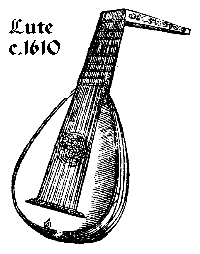 |
The Lute |

The Lute came originally from Arab countries - the name is a corruption of the Arabic name Al’Ud. Like other instruments, it spread throughout Europe in medieval times, probably as a direct result of the Crusades. Over several centuries, it gradually acquired more and more strings. The early medieval lute had just four single strings, and was often plucked with a feather. By the 15th century, a typical lute would have five double-strung courses, and it was now increasingly plucked with the fingers, allowing more complex music to be played. By the beginning of the sixteenth century, many lutes had six courses, and the six-course lute was the norm for most of the century. The first mention of a seventh course is in 1511, but it wasn't until the 1580s that seven courses became common enough for music to be published for it. The most common arrangement for a seven course lute was a single top string, five double-strung unison courses, and a unison or octave seventh. This is now usually regarded as the ‘‘classical’’ lute, for which most of the greatest composers wrote. John Dowland is probably the most famous, but there were very many lutenists producing music of the highest quality. The lute was phenomenally popular, and was to be seen everywhere, from the highest court to the lowest tavern. In social terms, it was the sixteenth century’s equivalent of the nineteenth century piano or the modern hi-fi stack. Like other instruments of the period, lutes were made in several sizes, and played in lute consorts. Seven courses wasn't by any means the limit. Towards the end of the sixteenth century, and into the early seventeenth, more courses were added, until some models had eleven or more courses on a very wide fingerboard, which was rather impractical. New types of lute (archlutes, theorbos, chitarroni) were being developed. These instruments varied in their details, but their common feature was an extended neck. Part of the neck now held the standard fingerboard, having the old six or seven courses, and a pegbox was inserted in its usual place to tune these strings. The rest of the neck carried on past the first pegbox, and held at least seven bass strings, which were played as open strings. Another pegbox was placed at the top of the neck to tune the basses. Some models actually had two sets of bass strings, requiring three pegboxes in total. The extensions on archlutes were quite modest, but some lutes had very long necks. It was not uncommon for Italian chitarrone, used as continuo instruments in the new opera bands, to exceed seven feet in overall length. Various developments and experiments continued during the seventeenth century. By the beginning of the eighteenth century, lutes had firmly divided into the big continuo instruments, which were slowly going out of fashion in favour of the harpsichord, and the smaller, fairly standardised, chamber lute - what we now call the "baroque lute". The early eighteenth century produced the second flowering of the lute as a chamber instrument. Another huge corpus of very fine music was written for it, most of which was unknown until very recently, due to the lack of reproduction baroque lutes, the phenomenal technique required to play the thing, and the idiomatic nature of the music, which rarely transcribes successfully to other instruments. J.S. Bach wrote several lute suites, but its greatest exponent was probably Silvius Leopold Weiss, who deserves to be numbered among the first rank of baroque composers. Fortunately, there are now a number of decent baroque lute players, and recordings of his music are available. Haydn occasionally wrote for the lute, but the instrument gradually died out until the renaissance lute was revived in the twentieth century by enthusiasts wanting to play the Elizabethan repertoire on the right instrument. The lute is sometimes confused
with the much smaller Mandolin, a regional development of the treble lute, which was largely
confined to its native Naples until it achieved novelty status in the mid-eighteenth century
(anyone heard the Vivaldi mandolin concertos?). It became a popular Victorian folk instrument,
and it's still used extensively by folk groups. Don't believe Hollywood's idea of Troubadours
playing it, though - it's about 400 years too modern. For that matter, don't believe anything
on film that involves music history. The film industry's record, particularly in America,
varies from apathetic, via patronising, to pure fantasy. Just ignore the facts and enjoy the
show, like good little boys and girls. Pam is our star lutenist. And the guitarist. And the cittern player and the theorbo player and the gittern player and... well, she's just good with strings. She even has a genuine Arabic Ud, which she haggled out of a street player last time she was in Egypt. I stick to my hurdy-gurdies and symphonies. They're quite enough to cope with. |
 Diabolus Homepage |
 Look up another Instrument |
 Email for Diabolus |